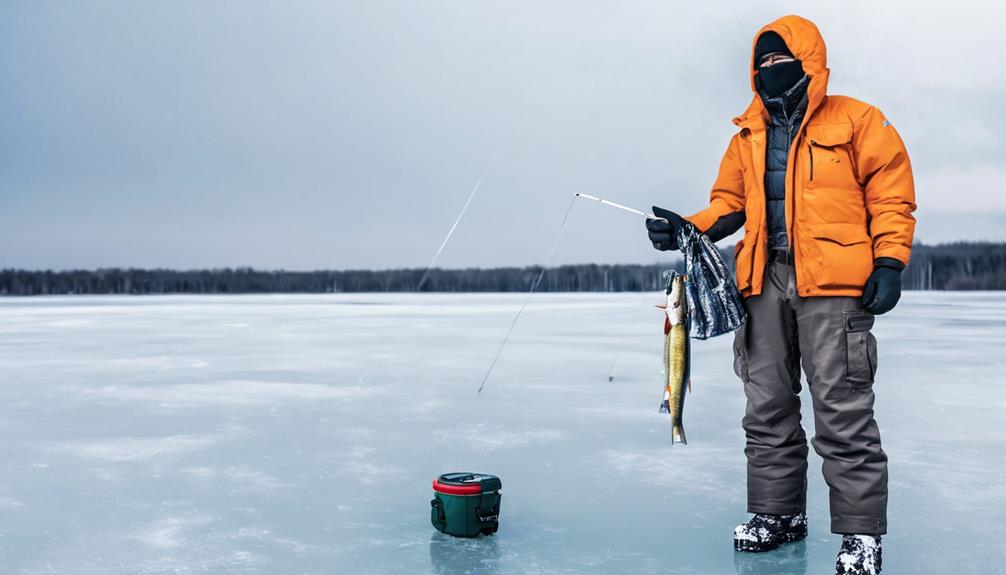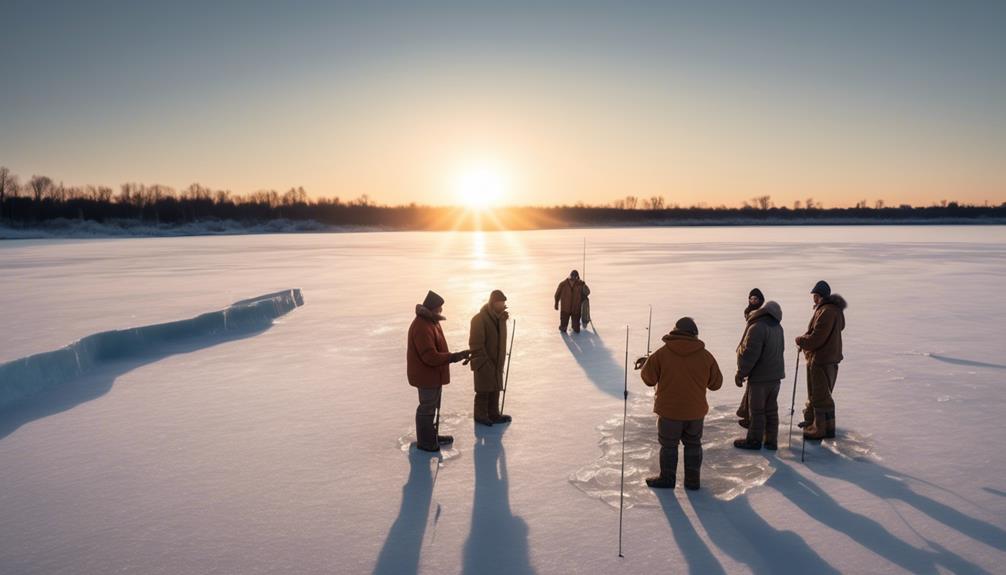When gearing up for ice fishing, you need to ensure you have the right tools for the job. From ice fishing rods to safety gear, each essential piece plays a crucial role in your success on the ice.
But what exactly are the top 10 must-have gear essentials that you should have in your arsenal? Let's explore each item and its significance in enhancing your ice fishing experience.
Ice Fishing Rods
When ice fishing, you'll want a durable and sensitive rod that can withstand the harsh conditions and help you feel even the subtlest bites. Rod sensitivity is crucial when ice fishing as it allows you to detect the smallest movements from the fish, ensuring you don't miss any potential catches.
Look for a rod with high sensitivity, such as those made from graphite or fiberglass, as they can transmit even the faintest fish movements up the line to your hand.
Additionally, consider the rod length. A shorter rod, typically around 24-30 inches, offers better control when fishing in tight spaces or when targeting smaller fish. On the other hand, longer rods, ranging from 36-48 inches, provide greater leverage when battling larger fish and can help manage heavier lines and lures.
The length of the rod also affects the strike detection capability, with longer rods allowing for a wider fishing area coverage, while shorter rods offer more precision in strike detection. Choose a rod length based on the type of fish you're targeting and the specific conditions of the ice fishing location.
Ice Fishing Reels
Consider choosing an ice fishing reel that offers smooth drag and efficient line retrieval to complement your ice fishing rod. When it comes to reel selection, prioritize durability and functionality to withstand the harsh conditions of ice fishing. Look for reels specifically designed for ice fishing, as they're built to perform optimally in cold weather. Choose a reel size that matches the line weight you'll be using, ensuring that it can handle the rigors of ice fishing.
Reel maintenance is crucial for ensuring your equipment functions smoothly during your ice fishing expeditions. After each use, make it a habit to clean and lubricate your reel to prevent ice buildup and corrosion. This simple step can significantly extend the lifespan of your reel and maintain its performance over time. Additionally, inspect the reel for any signs of wear and tear, and address any issues promptly to avoid potential malfunctions on the ice.
When selecting an ice fishing reel, consider whether you prefer a spinning reel or an inline reel. Spinning reels are versatile and easy to use, making them suitable for various fishing techniques. On the other hand, inline reels have a more traditional feel and provide precise jig control, making them a popular choice for anglers focused on jigging. Ultimately, the best ice fishing reel for you'll depend on your personal preferences and the specific fishing techniques you plan to employ.
Ice Fishing Shelters
To ensure your comfort and protection from the elements during your ice fishing excursions, investing in a sturdy and well-insulated ice fishing shelter is essential. When it comes to shelter insulation, look for options with thick, durable fabric and efficient insulation to keep you warm in frigid conditions. A well-insulated shelter will help retain heat, making your ice fishing experience more enjoyable and comfortable, especially during long hours on the ice.
In addition to insulation, shelter setup is a crucial factor to consider. Look for shelters that are easy to set up and take down, as you don't want to spend a significant amount of time struggling with complicated assembly in the cold. Pop-up shelters are popular for their quick and straightforward setup, allowing you to spend more time fishing and less time dealing with the shelter.
When selecting an ice fishing shelter, consider the size based on the number of people who'll be using it. Some shelters are designed for solo anglers, while others can accommodate multiple people. Think about your specific needs and choose a size that provides enough space for you and your fishing companions without feeling cramped.
Ice Augers
Invest in a reliable ice auger to effortlessly drill holes in the ice, ensuring you can quickly set up your shelter and start fishing without wasting time. To keep your ice auger in top condition, regular maintenance is crucial. After each use, make sure to clean any ice and debris from the blades and the auger's body. Lubricate the moving parts to prevent rust and ensure smooth operation. Check the engine, if applicable, for any signs of wear and tear, and replace any worn-out parts to maintain optimal performance.
When it comes to choosing the right blades for your ice auger, consider the type of ice you'll be drilling through. For general use on various ice thicknesses, a standard straight blade is a versatile option. If you expect to encounter exceptionally hard ice, serrated blades can provide extra cutting power. On the other hand, if you mainly fish in softer ice conditions, consider investing in a set of curved blades, which can help prevent the auger from jumping around while drilling.
Proper maintenance and choosing the right blades for your ice auger are essential for a successful and enjoyable ice fishing experience. By taking care of your equipment and selecting the appropriate blades, you can ensure that drilling holes in the ice remains efficient and hassle-free, allowing you to focus on the thrill of the catch.
Ice Fishing Lines
Select high-quality, low-memory monofilament or fluorocarbon ice fishing lines to ensure durability and minimal tangling in cold conditions. When choosing an ice fishing line, line strength and durability are crucial factors to consider. The line should be strong enough to handle the potential challenges of ice fishing, such as dealing with larger fish species and abrasive ice edges. Look for lines specifically designed for cold weather conditions, as they're less likely to become brittle and prone to breakage.
In addition to strength and durability, line visibility and flexibility are equally important. A highly visible line can help you detect even the slightest fish movements, increasing your chances of successful catches. On the other hand, flexibility is essential for maintaining sensitivity and responsiveness in cold temperatures, allowing you to feel the subtle bites of fish in icy waters.
When ice fishing, the environment can be harsh, and the right fishing line can make a significant difference in your overall experience. Therefore, invest in a high-quality ice fishing line that offers the perfect balance of strength, durability, visibility, and flexibility. By doing so, you can enhance your chances of a successful ice fishing outing while minimizing the frustrations that may arise from using inferior fishing lines.
Ice Fishing Lures and Baits
When ice fishing, choosing the right lures and baits can significantly impact your success in catching fish. Bait selection is crucial, as different fish species respond to various types of bait. For example, if you're targeting panfish, using small live bait such as waxworms or maggots can be effective. On the other hand, predatory fish like pike or walleye may be more enticed by larger minnows or artificial lures. Understanding the preferences of the fish in your chosen location is essential for successful bait selection.
Fishing techniques also play a vital role in maximizing your catch. Once you've selected the appropriate bait, understanding how to present it effectively is key. For instance, when fishing for trout, using a technique called 'jigging' where you rapidly lift and drop the bait can mimic the movement of natural prey, attracting fish to bite. Similarly, for species like perch or crappie, using a stationary bait presentation method with a slight twitching action can be more appealing to these fish.
Lure presentation is equally important when it comes to attracting fish. Understanding the behavior of the fish you're targeting can help you determine the best way to present your lure. For instance, if you're targeting bottom-feeding fish such as catfish, presenting your lure close to the lakebed can increase your chances of a successful catch.
Ice Fishing Clothing

To stay warm and comfortable during ice fishing, it's essential to dress in layers and wear insulated waterproof clothing. Layering techniques are crucial for regulating body temperature in the cold, so start with a moisture-wicking base layer to keep sweat away from your skin. A good mid-layer, such as a fleece or down jacket, provides insulation, while a waterproof and windproof outer layer keeps you dry and shields you from harsh winds. This combination allows you to add or remove layers as needed to stay comfortable throughout the day on the ice.
When it comes to your feet, thermal socks are a game-changer. Keeping your feet warm and dry is essential for an enjoyable ice fishing experience. Thermal socks are designed to retain heat and wick away moisture, ensuring that your feet stay comfortable and protected from the cold. Additionally, insulated and waterproof boots are a must to keep your feet warm and dry in icy conditions. Look for boots with a thick sole to provide insulation from the frozen ground.
In addition to layering and thermal socks, don't forget to protect your hands and head. Insulated waterproof gloves or mittens are vital for keeping your hands warm and functional. Meanwhile, a good quality thermal hat or beanie helps to retain heat and protect your ears from the biting cold.
Ice Safety Gear
Ensuring your safety on the ice is paramount, and having the right ice safety gear is essential for your protection. When venturing out onto the ice, it's crucial to be prepared for any potential emergencies. Here are some must-have ice safety gear essentials:
- Ice Picks: These handheld tools are designed to help you pull yourself out of the water in case you fall through the ice. They feature sharp metal spikes that can grip the ice, providing leverage to lift yourself out of the frigid water.
- Personal Flotation Device (PFD): Wearing a PFD is a crucial ice safety tip. If the ice breaks beneath you, a PFD will keep you afloat, preventing you from submerging in the icy water. Look for specially designed ice fishing PFDs that offer freedom of movement and ample buoyancy.
- Throw Rope: A throw rope is an essential piece of emergency equipment. It allows you to quickly assist someone who's fallen through the ice by providing them with a lifeline to pull themselves to safety. Practice using the throw rope with your fishing buddies so that everyone is prepared for an emergency.
In addition to having the right gear, it's important to familiarize yourself with ice safety tips and emergency procedures. Always check the ice thickness before heading out, and never go alone. Knowing what to do in case of an emergency can make all the difference in ensuring a safe and enjoyable ice fishing experience.
Frequently Asked Questions
How Do I Choose the Best Spot to Set up My Ice Fishing Shelter?
When choosing a location for setting up your ice fishing shelter, look for areas with good fish activity and safe ice conditions. Consider using a fish finder to identify underwater structures and use proper fishing techniques for success.
What Are Some Common Safety Tips for Ice Fishing, Especially Regarding Ice Thickness and Potential Hazards?
When ice fishing, always check ice thickness before venturing out. Be mindful of potential hazards like thin ice, cracks, or changes in ice color. Take safety precautions by carrying ice picks, a life jacket, and staying informed about local ice conditions.
Are There Any Specific Techniques or Tips for Using Ice Fishing Lures and Baits Effectively?
When using ice fishing lures, focus on lure presentation and bait selection. Experiment with different ice fishing lure colors and jigging techniques to see what works best in your fishing spot.
What Type of Clothing Is Best for Staying Warm and Dry While Ice Fishing?
To stay warm and dry while ice fishing, the best clothing involves layering. Start with a moisture-wicking base layer, add insulating layers, and finish with a waterproof and windproof outer layer. This combination keeps you comfortable throughout the day.
Can You Provide Some Recommendations for the Best Types of Ice Fishing Lines for Different Fishing Conditions?
For different fishing conditions, the best ice fishing lines are fluorocarbon for stealth, monofilament for flexibility, and braided for sensitivity. These Ice fishing line recommendations cater to various needs, ensuring you have the right fishing line types.
Conclusion
So there you have it, the top 10 must-have ice fishing gear essentials.
With the right equipment, you'll be prepared to tackle the ice and reel in some big catches.
Whether you're a beginner or a seasoned ice angler, having these essentials in your arsenal will ensure a successful and enjoyable fishing experience.
So gear up, stay safe, and have a great time out on the ice!



